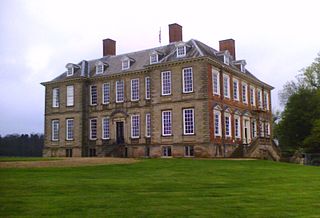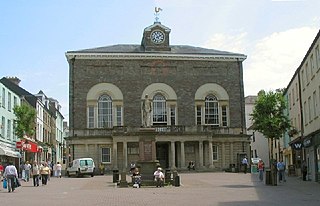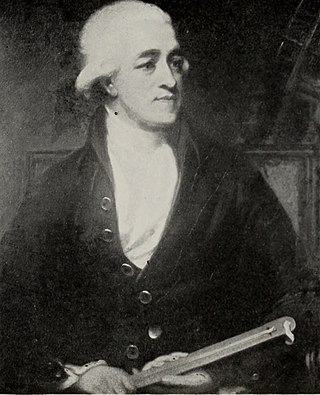
Putney is a district of south London, England, in the London Borough of Wandsworth, five miles southwest of Charing Cross. The area is identified in the London Plan as one of 35 major centres in Greater London.

Roehampton is an area in southwest London, in the Putney SW15 postal district, and takes up a far western strip, running north to south, in the London Borough of Wandsworth. It contains a number of large council house estates and is home to the University of Roehampton.

Charles Hatchett FRS FRSE was an English mineralogist and analytical chemist who discovered the element niobium, for which he proposed the name "columbium".

Stanford Hall is a stately home in Leicestershire, England, near the village of Stanford on Avon and the town of Lutterworth, Leicestershire. The population of any residents in the area is included in the civil parish of Misterton with Walcote.

The University of Roehampton, London, formerly Roehampton Institute of Higher Education, is a public university in the United Kingdom, situated on three major sites in Roehampton, in the London Borough of Wandsworth. The University traces its roots to four institutions founded in the 19th century, which today make up to university's constituent colleges, around which student accommodation is centred: Digby Stuart College, Froebel College, Southlands College and Whitelands College.

Sir Robert Taylor (1714–1788) was an English architect and sculptor who worked in London and the south of England.

Putney is a constituency created in 1918. It is currently represented in the House of Commons of the UK Parliament since 2019 by Fleur Anderson of the Labour Party. Putney was the only seat that Labour gained during the 2019 general election.

Sir George Augustus William Shuckburgh-Evelyn, 6th Baronet was a British politician, mathematician and astronomer.
Whitelands College is the oldest of the four constituent colleges of the University of Roehampton.
Garnett College was a higher education college in London which trained lecturers in further and higher education colleges between 1946 and 1988. Its main focus was on teaching towards post-graduate qualifications awarded by the Council for National Academic Awards (CNAA). Students had to be at least 25 years old and be qualified in their teaching subject.

Edward Clive, 1st Earl of Powis,, known as the Lord Clive between 1774 and 1804, was a British politician who sat in the House of Commons from 1774 to 1794 when he was raised to the peerage as Baron Clive.

The Alton Estate is a large council estate situated in Roehampton, southwest London. One of the largest council estates in the UK, it occupies an extensive area of land west of Roehampton village and runs between the Roehampton Lane through-road and Richmond Park Golf Courses.

Hugh Colin Smith was an English banker who was Governor of the Bank of England from 1897–99.

Humphrey St John-Mildmay (1794–1853) was an English merchant banker and politician, a partner with Baring Brothers.

Parkstead House, formerly known as Manresa House and Bessborough House, is a neo-classical Palladian villa in Roehampton, London, built in the 1760s. The house and remaining grounds are now Whitelands College, part of the University of Roehampton. It is situated on Holybourne Avenue, off Roehampton Lane, next to the Richmond Park Golf Course in the London Borough of Wandsworth. In 1955 it was designated Grade I on the National Heritage List for England.

Southlands College, in Roehampton in the London Borough of Wandsworth, is one of four colleges at the University of Roehampton and is the location of the University's Business School and its Department of Media, Culture and Language.

Sir John Henry Seale, 1st Baronet (1780–1844) of Mount Boone in the parish of Townstal near Dartmouth in Devon, was a Whig Member of Parliament for Dartmouth in 1838. He was created a baronet on 31 July 1838. He owned substantial lands in Devon, mainly at Townstal and Mount Boone. Together with the Earl of Morley of Saltram House near Plymouth, he built several bridges in Dartmouth, most notably the Dart crossing. Arthur Howe Holdsworth's, the previous Member of Parliament in Dartmouth, influence over the pocket borough of Dartmouth ceased after the 1832 Reform Act and subsequently he was in competition for that parliamentary seat with John Seale, who won the seat.

Dover House Estate is one of a number of important London County Council cottage estates inspired by the Garden city movement. The land was previously the estates of two large houses, Dover House and Putney Park House, which were purchased by the London County Council soon after World War I. Dover House was demolished for the new estate, but Putney Park House remains.
John Udny was a Scottish diplomat who served as British Consul at Venice and Leghorn.

Wildcroft Manor is a historic site in Putney in the London Borough of Wandsworth, with private housing and a Grade II Listed iron gateway.





















